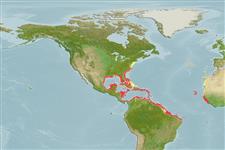>
Anguilliformes (Eels and morays) >
Muraenidae (Moray eels) > Muraeninae
Etymology: Gymnothorax: Greek, gymnos = naked + Greek, thorax, -akos = breast (Ref. 45335).
Environment: milieu / climate zone / depth range / distribution range
Ekologi
marina revassocierade; djupintervall 1 - 50 m (Ref. 58047), usually 5 - 30 m (Ref. 26938). Tropical; 42°N - 30°S, 99°W - 13°W (Ref. 55256)
Western Atlantic: New Jersey (USA), Bermuda, and northern Gulf of Mexico to Brazil. Recorded once from Nova Scotia, Canada. Eastern Atlantic and eastern Pacific (Ref. 26340).
Size / Vikt / Age
Maturity: Lm ? range ? - ? cm
Max length : 250 cm TL hane/ej könsbestämd; (Ref. 7251); common length : 150 cm TL hane/ej könsbestämd; (Ref. 5217); publicerad maxvikt: 29.0 kg (Ref. 9710)
Short description
Morfologi | Morfometri
Very large brown moray, uniformly dark green to brown (Ref. 26938).
A benthic and solitary species (Ref. 26340) occurring along rocky shorelines, reefs, and mangroves (Ref. 3255).Usually found shallower than 30 m (Ref. 26938). Due to its large size and aggressiveness, the bites of this moray are particularly dangerous (Ref. 3255). Feeds mainly at night on fish and crustaceans (Ref. 42064). Marketed fresh and salted (Ref. 3255). Large individuals are ciguatoxic (Ref. 3255).
Life cycle and mating behavior
Könsmognad | Reproduktion | Lek | Ägg | Fecundity | Larver
Spawning migrations and leptocephalus larvae (ref. 42064).
Robins, C.R. and G.C. Ray, 1986. A field guide to Atlantic coast fishes of North America. Houghton Mifflin Company, Boston, U.S.A. 354 p. (Ref. 7251)
IUCN Red List Status (Ref. 130435)
Threat to humans
Traumatogenic (Ref. 3255)
Human uses
Fiskeri: mindre kommeriell; Akvarium: Offentliga akvarier
Ytterligare information
referenserVattenbrukVattenbruksprofilAvelslinjerGenetikElectrophoresesÄrftlighetSjukdomarBehandlingNutrientsMass conversion
Verktyg
Special reports
Download XML
Internet-källor
Estimates based on models
Preferred temperature (Ref.
123201): 23.3 - 28, mean 26 °C (based on 476 cells).
Phylogenetic diversity index (Ref.
82804): PD
50 = 0.5000 [Uniqueness, from 0.5 = low to 2.0 = high].
Bayesian length-weight: a=0.00062 (0.00041 - 0.00093), b=3.27 (3.15 - 3.39), in cm total length, based on LWR estimates for this species & Genus-body shape (Ref.
93245).
Trofisk nivå (Ref.
69278): 4.0 ±0.71 se; based on food items.
Resiliens (Ref.
120179): Mycket låg, lägsta populationsfördubblingstid mer än 14 år (Preliminary K or Fecundity.).
Fishing Vulnerability (Ref.
59153): Very high vulnerability (90 of 100).
Nutrients (Ref.
124155): Calcium = 16 [8, 25] mg/100g; Iron = 0.4 [0.2, 0.8] mg/100g; Protein = 18.7 [16.4, 21.3] %; Omega3 = 0.0823 [, ] g/100g; Selenium = 60.6 [27.2, 130.1] μg/100g; VitaminA = 56.2 [13.7, 218.4] μg/100g; Zinc = 0.72 [0.49, 1.05] mg/100g (wet weight);
